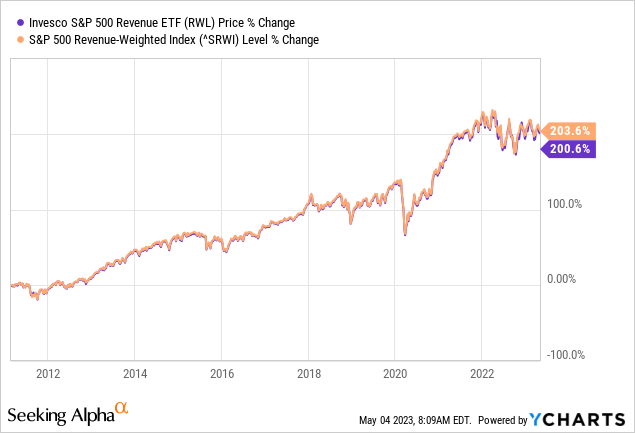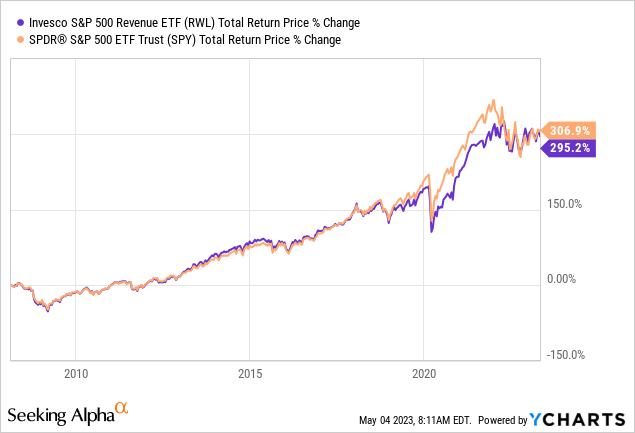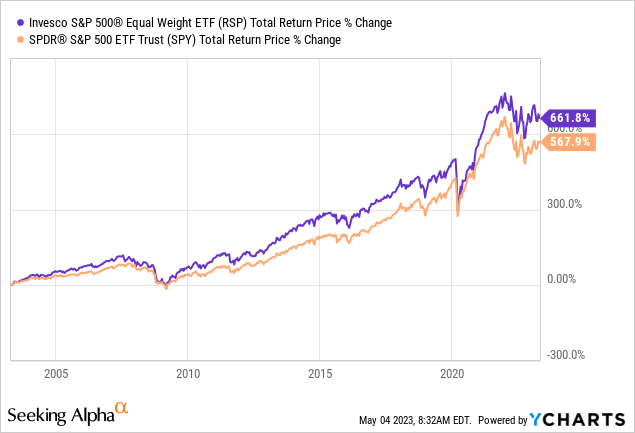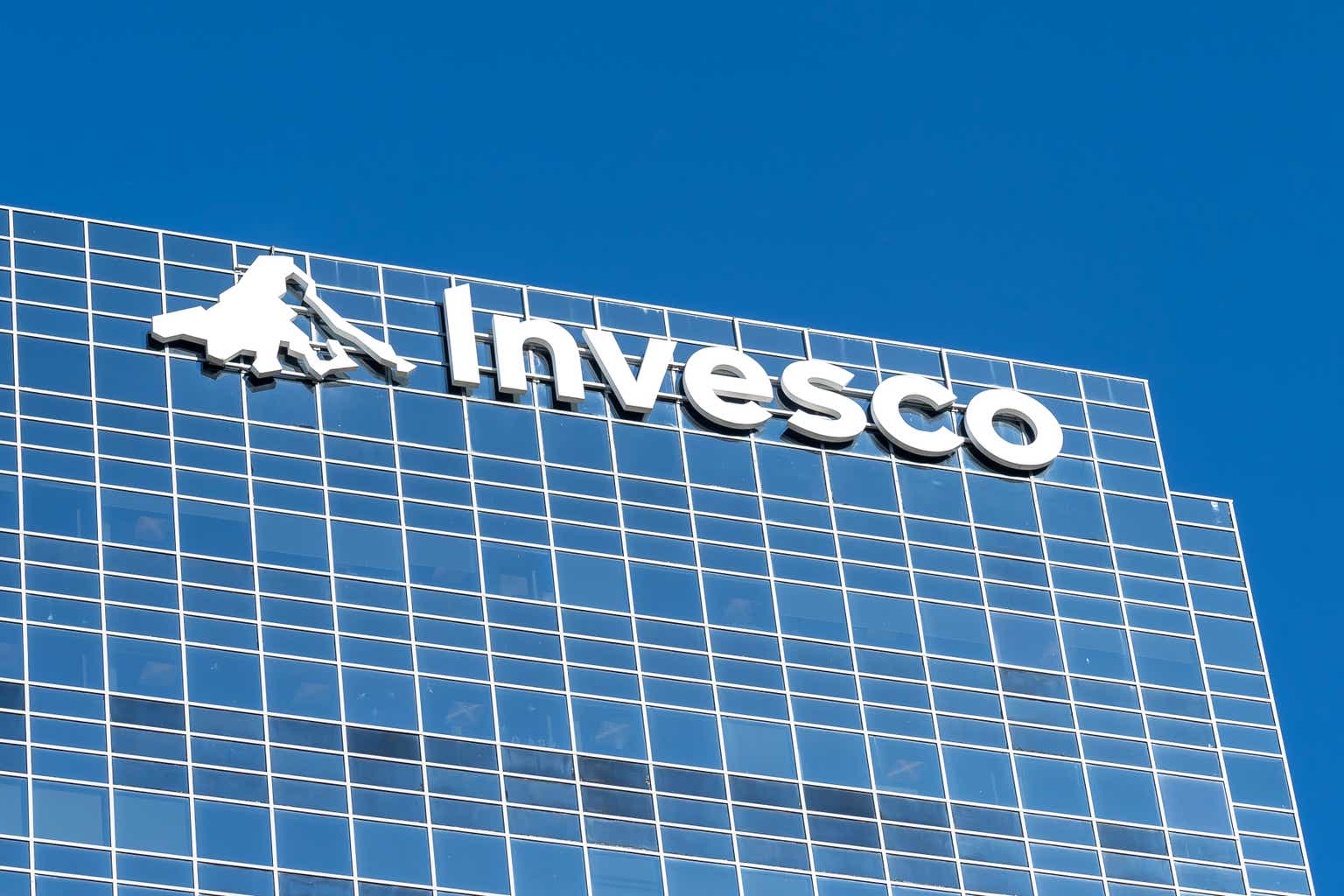Thesis
Invesco S&P 500 Revenue ETF (NYSEARCA:RWL) is an ETF which tracks an index that selects and weights S&P 500 constituents on the basis of revenue power. It’s unique in this approach as far as I know and it has been efficient in tracking that index.
Regardless, its approach hasn’t delivered greater returns than the market or at least shown signs of superior risk-adjusted returns. Its risk profile has actually been a bit worse than that of SPDR S&P 500 ETF Trust (SPY). Below, I am going to dive into it and also recommend you some alternatives to consider if you’re not content with a full-replication S&P 500 tracking ETF.
What does RWL do?
RWL is a full-replication index-tracking equity ETF issued on 02/19/2008 by Invesco Capital Management LLC and managed by the same. It currently manages about $1.74 billion.
More specifically, the fund’s goal is to deliver returns that are reflected in the price changes of the S&P 500 Revenue-Weighted Index, which its constituents are included in the underlying S&P 500 index and are selected based on positive revenues. The index weights the components based on the trailing 4-quarter revenue sum for each company divided by the underlying index’s total revenue, with a 5% concentration limit. For this reason, you can expect that the fund’s allocations may look significantly different than the usual S&P 500 index ETF.
The fund’s biggest positions are currently in Walmart Inc (WMT), Amazon.com Inc (AMZN), and Apple Inc (AAPL), with respective total asset allocations of 4.09%, 3.56%, and 2.67%. As for its sector allocations, the portfolio is mostly Health Care right now (18.9%), followed by Consumer Staples (13.36%) and Consumer Discretionary (12.11%).
RWL seems like the kind of fund that solves the problem investors in full-replication S&P 500 ETFs face; being overweight in float-adjusted market-cap stocks. For example, the top 5 holdings of SPY are tech stocks right now. RWL places importance on revenue power rather than size, so it’s interesting to see how it performed so far.
Performance
As RWL is an index-tracking ETF, the first thing I wanted to do was to gauge its efficiency by looking at how well it matched the price performance of its benchmark:

As it turns out, the fund’s long track record of closely matching the index shows how efficient it is. Despite its high fees, the difference in price performance is insignificant. And what makes this performance look even better is if you consider the length of the period the fund’s relative returns were measured above, which is about 15 years.
However, I believe that what must ultimately determine the value of investing in such a fund is how its different weighting strategy performed against a full-replication S&P 500 ETF. Unfortunately, there is an issue in making a case for RWL after a comparison to SPY.

For instance, we have a long period of performance here that allows us to develop a strong conviction that the ETF is not able to make something out of its revenue-weighting approach. Since RWL’s inception date, SPY has done better, albeit not much. And if you’re wondering about risk, there’s no developed case for RWL in that area either:
| Ticker | Maximum Drawdown | Standard Deviation Annualized | Sharpe |
| RWL | -48.99% | 17.45% | 0.59 |
| SPY | -46.33% | 16.21% | 0.63 |
Source: portfoliovisualizer.com (02/19/2008 – 5/4/2023)
This naturally leads me to the conclusion that there may be only some value to be derived by traders in some cases. But my experience in this area is insufficient to locate that value if it exists (leave a comment below if you have a thesis about RWL’s use). Therefore, I am going to proceed with some alternatives to RWL if you’re looking for something with a different approach to S&P 500 exposure that actually carries some utility for buy/hold investors.

First, I think that the outperformance of the Invesco S&P 500 Equal Weight ETF (RSP) speaks for itself. As the name implies, this is a fund which instead of market-cap weighting S&P 500 components, equally allocates its assets across them. This approach apparently was able to deliver better returns.
Some investors, however, require a low-volatility exposure to the market. To this end, I think that Invesco S&P 500 Low Volatility ETF (SPLV) seems effective:
| Ticker | Maximum Drawdown | Standard Deviation Annualized | Sharpe |
| SPLV | -21.37% | 11.78% | 0.85 |
| SPY | -23.93% | 14.62% | 0.8 |
Source: portfoliovisualizer.com (05/05/2011 – 5/4/2023)
Fees
RWL has an expense ratio of 0.39%. As expected, its fees are higher than what other ETFs that track the S&P 500 directly charge. Because there are no ETFs that do the same thing (to my knowledge, at least), the higher fees might make sense. Let’s also note that its job at tracking the index has been good so far.
However, as we witnessed above, the index probably isn’t worth tracking. Why would you pick a fund with a unique weighting strategy that bears no utility in regard to returns or risk? You wouldn’t; that’s why I believe the expense ratio within the context of RWL’s performance is high. Additionally, consider that RSP, the alternative fund that I mentioned above, has an equally simple weighting approach that provided greater returns and it charges 0.2%, nearly half of what RWL does.
Risks
For the usual full list of risks, I encourage you to look at the relevant prospectus. But I will mention some of them here as it’s typical to do so. The risks that I find the most significant to know which also apply to other ETFs like RWL are two.
First, RWL is a fund that invests in S&P 500 stocks so it’s exposed to a significant degree to market risk. As expected, its correlation to the index itself is high. Second, the index it tracks has weighting caps for individual holdings but does not have industry weighting limits in place. At times, this may make the fund concentrated in a particular industry to a significant degree.
Verdict
Though RWL is unique in its allocation methodology and has been efficient in tracking its index for a very long time, I don’t see any reason for an investor to consider investing in it. Its performance against the market has been underwhelming and it hasn’t made a case for less risk. Additionally, its fees would be fair if its strategy yielded a desirable result, so I think they are too high.
I may be wrong of course and I always expect that someone may find such an ETF’s approach useful under circumstances. If you’re that someone, I’m very curious to learn your thesis. Please, leave a comment below. Also, let me know whether you found this post helpful or not. Thank you for taking the time to read this and wish you good luck with your investment endeavors.
Read the full article here











